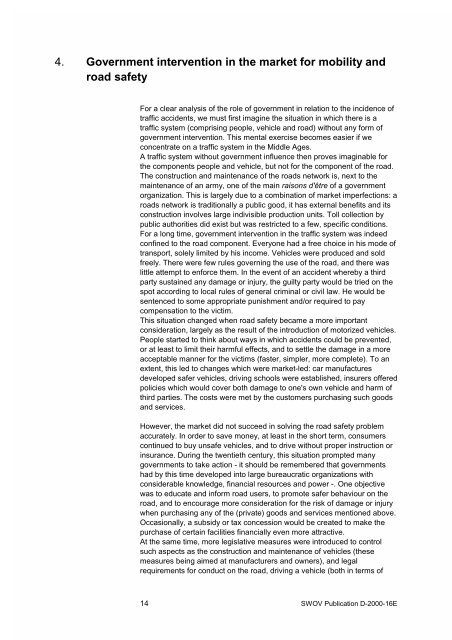Economic evaluation of road safety measures - Swov
Economic evaluation of road safety measures - Swov
Economic evaluation of road safety measures - Swov
Create successful ePaper yourself
Turn your PDF publications into a flip-book with our unique Google optimized e-Paper software.
4. Government intervention in the market for mobility and<br />
<strong>road</strong> <strong>safety</strong><br />
For a clear analysis <strong>of</strong> the role <strong>of</strong> government in relation to the incidence <strong>of</strong><br />
traffic accidents, we must first imagine the situation in which there is a<br />
traffic system (comprising people, vehicle and <strong>road</strong>) without any form <strong>of</strong><br />
government intervention. This mental exercise becomes easier if we<br />
concentrate on a traffic system in the Middle Ages.<br />
A traffic system without government influence then proves imaginable for<br />
the components people and vehicle, but not for the component <strong>of</strong> the <strong>road</strong>.<br />
The construction and maintenance <strong>of</strong> the <strong>road</strong>s network is, next to the<br />
maintenance <strong>of</strong> an army, one <strong>of</strong> the main raisons d'être <strong>of</strong> a government<br />
organization. This is largely due to a combination <strong>of</strong> market imperfections: a<br />
<strong>road</strong>s network is traditionally a public good, it has external benefits and its<br />
construction involves large indivisible production units. Toll collection by<br />
public authorities did exist but was restricted to a few, specific conditions.<br />
For a long time, government intervention in the traffic system was indeed<br />
confined to the <strong>road</strong> component. Everyone had a free choice in his mode <strong>of</strong><br />
transport, solely limited by his income. Vehicles were produced and sold<br />
freely. There were few rules governing the use <strong>of</strong> the <strong>road</strong>, and there was<br />
little attempt to enforce them. In the event <strong>of</strong> an accident whereby a third<br />
party sustained any damage or injury, the guilty party would be tried on the<br />
spot according to local rules <strong>of</strong> general criminal or civil law. He would be<br />
sentenced to some appropriate punishment and/or required to pay<br />
compensation to the victim.<br />
This situation changed when <strong>road</strong> <strong>safety</strong> became a more important<br />
consideration, largely as the result <strong>of</strong> the introduction <strong>of</strong> motorized vehicles.<br />
People started to think about ways in which accidents could be prevented,<br />
or at least to limit their harmful effects, and to settle the damage in a more<br />
acceptable manner for the victims (faster, simpler, more complete). To an<br />
extent, this led to changes which were market-led: car manufactures<br />
developed safer vehicles, driving schools were established, insurers <strong>of</strong>fered<br />
policies which would cover both damage to one's own vehicle and harm <strong>of</strong><br />
third parties. The costs were met by the customers purchasing such goods<br />
and services.<br />
However, the market did not succeed in solving the <strong>road</strong> <strong>safety</strong> problem<br />
accurately. In order to save money, at least in the short term, consumers<br />
continued to buy unsafe vehicles, and to drive without proper instruction or<br />
insurance. During the twentieth century, this situation prompted many<br />
governments to take action - it should be remembered that governments<br />
had by this time developed into large bureaucratic organizations with<br />
considerable knowledge, financial resources and power -. One objective<br />
was to educate and inform <strong>road</strong> users, to promote safer behaviour on the<br />
<strong>road</strong>, and to encourage more consideration for the risk <strong>of</strong> damage or injury<br />
when purchasing any <strong>of</strong> the (private) goods and services mentioned above.<br />
Occasionally, a subsidy or tax concession would be created to make the<br />
purchase <strong>of</strong> certain facilities financially even more attractive.<br />
At the same time, more legislative <strong>measures</strong> were introduced to control<br />
such aspects as the construction and maintenance <strong>of</strong> vehicles (these<br />
<strong>measures</strong> being aimed at manufacturers and owners), and legal<br />
requirements for conduct on the <strong>road</strong>, driving a vehicle (both in terms <strong>of</strong><br />
14 SWOV Publication D-2000-16E
















